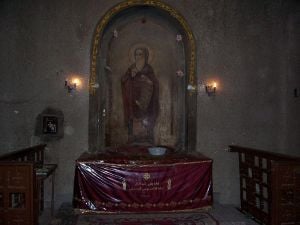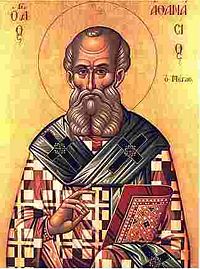Athanasius of Alexandria
Athanasius of Alexandria (also spelled "Athanasios") (c.293 – May 2, 373) was a Christian bishop, the Patriarch of Alexandria, in the fourth century. He is revered as a saint by the Roman Catholic Church, the Eastern Orthodox Church and the Oriental Orthodox Church, and regarded as a great leader of the Church by Protestants. Roman Catholics have declared him one of 33 Doctors of the Church, and he is counted as one of the four Great Doctors of the Eastern Church. His feast day is Pashons 7 (May 15) in the Oriental Orthodox Churches), January 18 in the Eastern Orthodox Churches and May 2 in the Roman Catholic and Episcopal Churches.
| Saint Athanasius | |
|---|---|
Saint Athanasius | |
| Doctors of the Church | |
| Born | 293 in Alexandria, Egypt |
| Died | May 21, 373 in Alexandria, Egypt |
| Venerated in | Roman Catholic Church, Eastern Orthodox Churches, Oriental Orthodox Churches |
| Major shrine | Saint Mark Coptic Orthodox Cathedral in Cairo, Egypt Santa Croce, Venice, Italy |
| Feast | May 2 (Roman Catholic) January 18(Eastern Orthodox) May 15 = Pashons 7 (Oriental Orthodox) |
| Attributes | bishop arguing with a pagan; bishop holding an open book; bishop standing over a defeated heretic |
History
Athanasius was born of upper-class parents in the Egyptian city of Alexandria. He would probably have been familiar with the Alexandrian Catechetical School, and would have been around 10 years old when in 303 Maximian sent hundreds of martyrs to the stake, including some who had been teachers at that school. The leader of the church there, Bishop Alexander enrolled the young Athanasius in a private study course. In the same city, Arius also lived, and the Arianism which he espoused would lead to the eventual doctrinal clash for which Athanasius is most remembered.
Probably around 318, Athanasius wrote a double treatise entitled Against the Gentiles — On the Incarnation, affirming and explaining that Jesus was both God and Man. In his major theological opus, the Three Discourses Against the Arians, Athanasius stressed that the Father's begetting of the Son, or uttering of the Word, was an eternal relationship between them, not an event that took place within time. He makes very sparing use of the key-word of Nicaea, homoousios (consubstantial). These writings lay the foundation of Christianity's fight against the heresy of Arianism, which Athanasius opposed all his life.
Having shown his mettle as a great theologian, he was the appointed as archdeacon and secretary to Bishop Alexander.
| Part of a series of articles on Christianity | ||||||

| ||||||
|
Foundations Bible Christian theology History and traditions
Topics in Christianity Important figures | ||||||
|
Christianity Portal | ||||||
Historical significance
Opposition to Arianism
In about 319, when Athanasius was a deacon, a presbyter named Arius began teaching that there was a time when Jesus did not exist and that he had been created by God - a view which came to be known as Arianism. Athanasius accompanied Alexander to the First Council of Nicaea in 325, which council produced the Nicene Creed and anathematized Arius and his followers. On May 9, 328, he succeeded Alexander as bishop of Alexandria. As a result of rises and falls in Arianism's influence after the First Council of Nicaea, he was banished from Alexandria to Tyre by Emperor Constantine I only to be later restored after the death of Constantine I by his son Constantine II. Athanasius was restored on at least five separate occasions, perhaps as many as seven. This gave rise to the expression "Athanasius contra mundum" or "Athanasius against the world". During some of his exiles, he spent time with the Desert Fathers, monks and hermits who lived in remote areas of Egypt. Despite his doctrinal firmness, he showed diplomatic flair in rallying the Orthodox at the Council of Alexandria in 362.
Other Writings
He also wrote a defence of the divinity of the Holy Spirit (Letters to Serapion) in the 360s, and wrote a polemic (On the Holy Spirit) against the Macedonian heresy.
Athanasius also wrote a biography of Anthony the Great entitled Vita Antonii, or Life of Antony, that later served as an inspiration to Christian monastics in both the East and the West. The Athanasian Creed is traditionally ascribed to him.
New Testament canon
Athanasius is also the first person to identify the same 27 books of the New Testament that are in use today. Up until then, various similar lists of works to be read in churches were in use. A milestone in the evolution of the canon of New Testament books is his Easter letter from Alexandria, written in 367, usually referred to as his 39th Festal Letter. Pope Damasus, the Bishop of Rome in 382, promulgated a list of books which contained a New Testament canon identical to that of Athanasius. A synod in Hippone in 393 repeated Athansius' and Damasus' New Testament list (without the Epistle to the Hebrews), and a synod in Carthage in 397 repeated Athanasius' and Damasus' complete New Testament list.
Scholars have debated whether Athanasius' list in 367 was the basis for the later lists. Because Athanasius' canon is the closest canon of any of the Church Fathers to the canon used by Protestant churches today many Protestants point to Athanasius as the father of the canon. They are identical except that Athanasius includes the Book of Baruch and the Letter of Jeremiah and places the Book of Esther among the apocrypha along with the Wisdom of Solomon, Sirach (Ecclesiasticus), Judith, Tobit, the Didache, and the Shepherd of Hermas.[1] See the article, Biblical canon, for more details.
Relics and veneration

The saint was originally buried in Alexandria, but his body was later transferred to Italy. Pope Shenouda III restored the relics of St. Athanasius back to Egypt on 15 May 1973 [1], after his historic visit to the Vatican and meeting with Pope Paul VI. The relics of St. Athanasius the Great of Alexandria are currently preserved under the new St. Mark Coptic Orthodox Cathedral in Deir El-Anba Rowais, Abbassiya, Cairo, Egypt.
The following is a troparion (hymn) to St. Athanasius sung in some Orthodox churches.
- O holy father Athanasius,
- like a pillar of orthodoxy
- you refuted the heretical nonsense of Arius
- by insisting that the Father and the Son are equal in essence.
- O venerable father, beg Christ our God to save our souls.
Criticism of Athanasius
Some modern historians suggest that the tactics of Athanasius, while often downplayed by church historians, were a significant factor in his success. He did not hesitate to back up his theological views with the use of force. In Alexandria, he assembled a group that could instigate a riot in the city if needed. It was an arrangement "built up and perpetuated by violence."[2] Along with the standard method of excommunication he used beatings, intimidation, kidnapping and imprisonment to silence his theological opponents. Unsurprisingly, these tactics caused widespread distrust and led him to being tried many times for "bribery, theft, extortion, sacrilege, treason and murder.[3] While the charges rarely stuck, his reputation was a major factor in his multiple exiles from Alexandria. He justified these tactics with the argument that he was saving all future Christians from hell. Athanasius stubbornly refused to compromise his theological views by stating, "What is at stake is not just a theological theory but people's salvation."[4] He played a clear role in making the Constantinian shift a part of the theology of the church.
However, there are also many modern historians who object to this view and point out that such hostile attitude towards Athanasius is based on an unfair judgement of historical sources.[5] There are at present two completely opposite views about the personality of Athanasius. While some scholars praise him as an orthodox saint with great character, some see him as a power-hungry politician, or even a violent gangster. Both parties claim to have strong evidence supporting their views.
See also
- Creed
- Nicene Creed
- Apostles' Creed
- Athanasian Creed
- Shield of the Trinity
ReferencesISBN links support NWE through referral fees
- Arnold, Duane W.-H., 1991 The Early Episcopal Career of Athanasius of Alexandria
- Barnes, Timothy, 1981 Constantine and Eusebius
- Brakke, David, 1995. Athanasius and the Politics of Asceticism
- Ernest, James D., 2004. The Bible in Athanasius of Alexandria
- Ng, Nathan K. K., 2001 The Spirituality of Athanasius
- Olson, Roger E., 1999 The Story of Christian Theology
- Rubenstein, Richarde, 1999 When Jesus Became God: The Struggle to Define Christianity during the Last Days of Rome
Notes
External links
- Background information, plus his actual writings
- The Athanasian Creed
- Athanasius Select Resources, Bilingual Anthology (in Greek original and English)
- The Life and Ministry of Athanasius, John Piper
| Preceded by: Alexander |
Patriarch of Alexandria 328–373 or 328-339 346-373 |
Succeeded by: PeterII Gregory of Cappadocia (arian antipatriarch, not acknowledged) Peter II |
{
Credits
New World Encyclopedia writers and editors rewrote and completed the Wikipedia article in accordance with New World Encyclopedia standards. This article abides by terms of the Creative Commons CC-by-sa 3.0 License (CC-by-sa), which may be used and disseminated with proper attribution. Credit is due under the terms of this license that can reference both the New World Encyclopedia contributors and the selfless volunteer contributors of the Wikimedia Foundation. To cite this article click here for a list of acceptable citing formats.The history of earlier contributions by wikipedians is accessible to researchers here:
The history of this article since it was imported to New World Encyclopedia:
Note: Some restrictions may apply to use of individual images which are separately licensed.
